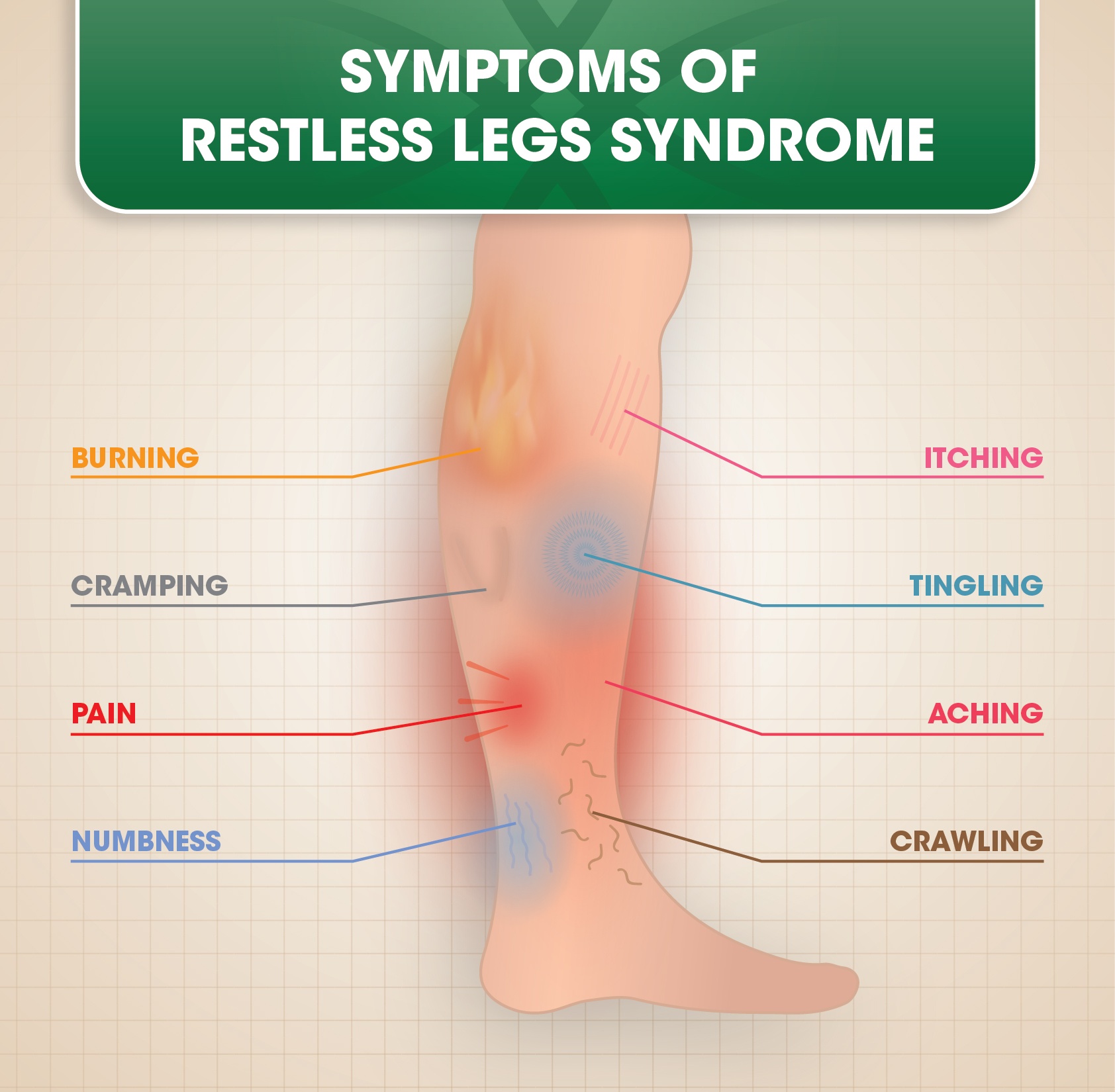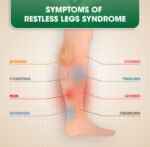Gabapentin is often prescribed to treat Restless Legs Syndrome (RLS), particularly in cases where other medications might not be suitable or effective.
Restless Legs Syndrome (RLS), also known as Willis-Ekbom Disease, is a neurological disorder characterized by an uncontrollable urge to move the legs, typically due to uncomfortable sensations. These sensations usually occur when a person is at rest, such as sitting or lying down, and they are often relieved temporarily by movement.
Key Features of Restless Legs Syndrome (RLS)
1. Uncomfortable Sensations in the Legs
- People with RLS often describe these sensations as itching, crawling, pulling, tingling, or burning.
- The discomfort usually occurs deep within the legs, typically between the knee and ankle, although it can also affect the arms or other body parts.
- The sensations are usually worse in the evening or at night, making it difficult for individuals to relax or fall asleep.
2. Urge to Move the Legs
- The hallmark of RLS is a strong urge to move the legs to relieve discomfort.
- Moving the legs—such as stretching, walking, or shaking them—often provides temporary relief from the unpleasant sensations.
Symptoms of RLS
- Uncomfortable Leg Sensations: Often described as a creeping, throbbing, or pulling sensation, typically worse during periods of inactivity.
- Worsening of Symptoms at Night: Symptoms tend to intensify in the evening or nighttime, leading to sleep disturbances.
- Temporary Relief with Movement: Physical movement, such as walking or stretching, temporarily alleviates the discomfort.
- Sleep Disruptions: Many individuals with RLS struggle with insomnia or disrupted sleep due to the need to move their legs.
Gabapentin can help alleviate the uncomfortable sensations and urge to move the legs that are characteristic of RLS.

How Gabapentin Works for RLS ?
- Gabapentin is an anticonvulsant and neuropathic pain medication. It’s thought to work by modulating neurotransmitters in the brain, especially those related to pain signaling and nerve activity.
- In the case of RLS, gabapentin appears to reduce nerve excitability and help normalize sensory signals, thereby decreasing the uncomfortable sensations in the legs.
Effectiveness of Gabapentin for RLS
- Studies have shown that gabapentin can reduce the frequency and intensity of RLS symptoms, improve sleep quality, and help patients fall asleep faster.
- It is particularly effective in individuals who have painful RLS or experience significant sleep disturbances due to the condition.
- Gabapentin enacarbil, a prodrug of gabapentin, is specifically approved by the FDA for the treatment of moderate to severe RLS. It is designed to have better absorption and more consistent blood levels than standard gabapentin.

Gabapentin Dosage for RLS
- The dosage of gabapentin for RLS can vary but is generally lower than dosages used for seizure control or neuropathic pain.
- Treatment often starts with a low dose (e.g., 100-300 mg) taken in the evening, about 2 hours before bedtime, and may be adjusted based on symptom severity and individual response.
- Gabapentin enacarbil is usually taken once daily, in the late afternoon or evening, as it has a longer duration of action.
Benefits of Using Gabapentin for RLS
- Improved Sleep: Gabapentin can improve sleep by reducing leg discomfort that tends to worsen at night.
- Less Dopamine-Related Side Effects: Unlike dopamine agonists (another common class of RLS medications), gabapentin does not typically cause issues like impulsive behavior or augmentation (a worsening of RLS symptoms over time).
- Pain Relief: It is particularly helpful for individuals who experience painful symptoms associated with RLS.
Potential Side Effects
- Drowsiness or Fatigue: Gabapentin can cause drowsiness, which might be beneficial for sleep disturbances but problematic during the day.
- Dizziness: Some individuals may experience dizziness, especially when starting the medication or adjusting the dosage.
- Weight Gain: In some cases, gabapentin can cause weight gain over time.
- Peripheral Edema: Swelling of the legs or ankles may occur.
- Coordination Issues: Gabapentin can cause mild coordination problems or a sense of unsteadiness.
Considerations Before Taking Gabapentin for RLS
- Discuss with Your Doctor: Ensure a thorough evaluation of your symptoms, medical history, and any other medications you are taking to avoid potential interactions.
- Titrate Slowly: Gabapentin should be started at a low dose and gradually increased to minimize side effects.
- Monitor Side Effects: Keep track of any new or unusual symptoms after starting the medication, and report them to your healthcare provider.
- Avoid Alcohol: Combining gabapentin with alcohol can increase drowsiness and other side effects.
- Not Suitable for Everyone: Gabapentin may not be appropriate for people with certain medical conditions, such as severe kidney impairment, without proper dose adjustments.
Alternative Treatments for RLS
If gabapentin is not effective or well-tolerated, there are other options for managing RLS, including:
- Dopamine Agonists: Such as pramipexole or ropinirole.
- Iron Supplements: If iron deficiency is present, iron supplementation can help alleviate symptoms.
- Lifestyle Changes: Regular exercise, good sleep hygiene, reducing caffeine, and stress management can help manage mild RLS symptoms.
- Other Medications: Opioids, benzodiazepines, or other anticonvulsants like pregabalin may be considered in certain cases.
Key Takeaway
Gabapentin can be an effective treatment for Restless Legs Syndrome, particularly for those with painful symptoms or sleep disturbances. It’s important to work closely with a healthcare provider to find the right dosage and monitor for side effects, ensuring that the benefits of treatment outweigh any potential risks.
Pain Medications, Pain Relief, and Pain Management






